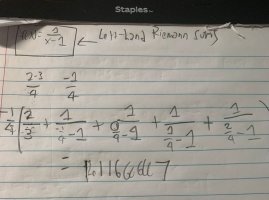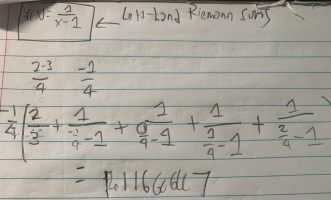lasvegas666
New member
- Joined
- Mar 1, 2024
- Messages
- 32
Since you've successfully done a left Riemann sum in another thread, please give it a try here, and show your work, so we can see what help you need.View attachment 38026
I don't know how to find the approximate answer to this Riemann sum problem. Additionally, I'm not asking for the answer. I'm asking for help with finding out the problem-solving methodology so that I can come to the correct answer on my own.
I legit don't know how to solve this problem because it's asking me for an approximate decimal answer.Since you've successfully done a left Riemann sum in another thread, please give it a try here, and show your work, so we can see what help you need.
Do you know what Riemann sum is? If not, have you searched for the definition?I legit don't know how to solve this problem because it's asking me for an approximate decimal answer.
A Riemann sum is the area sum of the values on a graph for a given function.Do you know what Riemann sum is? If not, have you searched for the definition?
But the method is the same as what you did here:I legit don't know how to solve this problem because it's asking me for an approximate decimal answer.
But the method is the same as what you did here:
How do I solve this problem? left Riemann sum, 8 subintervals on [0,8] for area under curve
I'm having trouble comprehending how I can solve this problem on my own.www.freemathhelp.com
The only difference is that you have to calculate the values of f(x), rather than being given them in a graph, and the numbers involved will not be whole numbers. Don't let decimals scare you. (And any Riemann sum is an approximation to the actual area.)
Here is an example of such a calculation:
(See problem 6 at the bottom for maximum similarity.)Left Riemann Sums | Mathmatique
www.mathmatique.com

The sum in your picture makes no sense to me.
Alright. I tried to use the [math](b-a) / n[/math] method to get -1/4, and then I just added one to the other four interval points when calculating my answer.The sum in your picture makes no sense to me.
What are the values of 'x' at the left end of each subinterval?
What are the values of [imath]1/(x-1)[/imath] for those values of 'x' ?
BTW, the sum in your picture has 5 terms, but are asked to use 4 subintervals.
Can you write down and post answers to my questions in post #8?Alright. I tried to use the [math](b-a) / n[/math] method to get -1/4, and then I just added one to the other four interval points when calculating my answer.
I answered that.Can you write down and post answers to my questions in post #8?
Verbal descriptions of math solutions are rarely useful
And I've done the best I could to help.I answered that.
I would just like help finding the answer to this problem.
Let's look through what you wrote bit by bit.I tried doing this but I didn't get the right answer.

